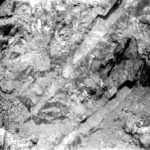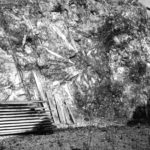South Dakota has no shortage of historic “tourist attraction” ghost towns, complete with gift shops and tour guides. But if you’re looking for a unique glimpse into the history of the Black Hills, take a walk off the beaten path and go hunting for these ghost towns hidden away in the hills.
Located only a few miles from downtown Keystone, Etta Mine is a jaw-dropping open cut mine with views of Mount Rushmore. At the bottom of the cut is a small lake with a beach area – filled with fish and littered with old fishing hooks. The mine has a rich history (both literally and figuratively) as the biggest spodumene mine in the United States.
Spodumene occurs in large crystals — used as a source of lithium metal. Most lithium is now produced from subsurface brines in Chile, Argentina and China but spodumene is still used when lithium of the highest purity is needed, as lithium produced from spodumene has fewer contaminants than lithium produced from brines. Etta Mine had one of the earliest accounts of these enormous spodumene crystals.
The United States Geological Survey Bulletin 610 reported about Etta Mine: “The crystals are often of enormous size. In the Etta Mine, where they are best exposed both in the open cut and tunnel, they frequently attain a diameter of three to four feet and a length of 30 feet. The largest “log” so far found was 42 feet long and 5 feet 4 inches in maximum diameter. This one log alone would yield 90 tons of spodumene.”
Dr. S.H. Ferguson discovered the Etta Mine in 1883 – getting its start as a mica mine. A sample of cassiterite tin ore was sent to California to be evaluated, and soon after it became a profitable tin mine. The Harney Peak Tin Milling, Mining, and Manufacturing Company bought Etta Mine, as well as over 1000 other claims.
A settlement called Etta Camp grew near the mine, and a mill and smelter were built in 1883. Until about 1900, Etta Camp had the only post office in the Keystone area.
The mine closed in 1886 after it failed to turn a profit, reopening in 1898 as a spodumene mine. In 1899, 500 tons of spodumene were extracted and 700 tons the following year. The largest spodumene crystal in the world was found here.
This made Etta Mine the most productive spodumene mine in the United States.
In 1904 in Harney Peak Mining News, the receiver of the Harney Peak Tin Mining, Milling, and Manufacturing Company, A.R. LeDoux, was interviewed about the Etta Mine.
He stated: “The Etta is one of the company’s most valuable pieces of property. It is probably one of the richest mineralized hills in the world. It resembles somewhat the core of an ancient volcano, and in it are found a wonderful variety of minerals. Tin, mica, spodumene, lepidolite, manganese, beryl, wolframite, tourmaline, feldspar and a dozen other minerals of greater or lesser importance are mined from it. The company has derived several thousand dollars from royalties on leases of this property alone. No leases have been given on the tin ores, but on the other minerals.”
The mine remained in operation continuously until 1936. It had periods of being closed and reopened several times, but closed for good by 1968.
Etta Camp was abandoned as the mine declined.
Before exploring the site, obtain permission from the landowners. It is a steep drop to the bottom of the open cut, so proceed with extreme caution.
By Kelsey Sinclair
Historic photos by the United States Geological Survey


